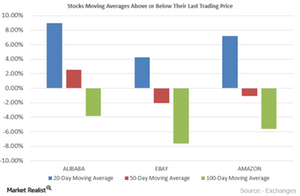What Are Analysts’ Recommendations for Alibaba?
As of March 4, 2016, Alibaba (BABA) has generated returns of -16.1% for the trailing 12 months and -15.3% in the trailing-one-month period.
March 12 2016, Updated 2:05 p.m. ET

Shareholder returns and stock trends
As of March 4, 2016, Alibaba (BABA) has generated returns of -16.1% for the trailing 12 months (or TTM) and -15.3% in the trailing-one-month period. The share price of the firm has increased by 7.9% in the trailing-five-day period.
Alibaba’s (BABA) peers Amazon (AMZN) and eBay (EBAY) have generated returns of 3.6% and 0.95%, respectively, in the trailing-five-day period.
Moving averages
On March 4, 2016, the last trading price of Alibaba (BABA) was $72.2. The company’s stock was trading 9.0% above its 20-day moving average of $66.3, 2.5% above its 50-day moving average of $70.4, and 3.8% below its 100-day moving average of $75.1.
Moving average convergence divergence and relative strength index
The MACD (or moving average convergence divergence) is the difference between the short-term and long-term moving averages of a firm. Alibaba’s (BABA) 14-day MACD of -0.49 shows a downward trading trend, as the figure is negative.
The 14-day relative strength index (or RSI) for Alibaba (BABA) is 63, which shows that the stock was somewhat overbought. If the RSI is above 70, it indicates the stock has been overbought. An RSI figure below 30 suggests that a stock has been oversold.
Analyst recommendations
Out of 45 analysts covering Alibaba (BABA), 40 have a “buy” recommendation, and five have a “hold” recommendation. The analyst stock price target for the company is $92.6 with a median target estimate of $90.3. Alibaba (BABA) is trading at a discount of 20.0% with respect to its median target.
Alibaba (BABA) and Walmart (WMT) constitute 1.3% and 0.59% of the SPDR S&P 500 ETF (SPY), respectively.
